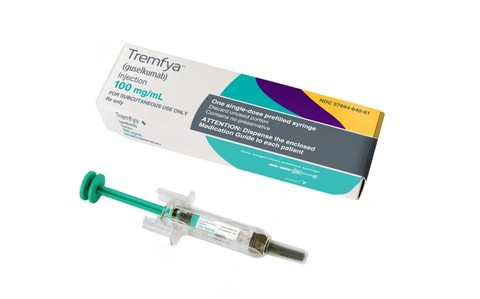
Johnson & Johnson has submitted an application to the FDA for the approval of Tremfya in psoriatic arthritis, which could further congest an intensely competitive therapy area.
Tremfya (guselkumab) is Janssen’s follow-up to IL-23/IL-12 inhibitor blockbuster Stelara (ustekinumab), which has faced competition from rival new treatments across immunology indications.
This includes Novartis’ Consentyx (secukinumab), AbbVie’s Skyrizi (risankizumab), Eli Lilly’s Taltz (ixekizumab) and Pfizer’s Xeljanz (tofacitinib citrate) , which are all already approved in psoriatic arthritis.
The application to the FDA is based on the top line results from the pivotal phase 3 trials of Tremfya, DISCOVER-1 and DISCOVER-2.
The drug hit its primary endpoint of ACR20 response at week 24, and multiple secondary endpoints including ACR50/70, resolution of soft tissue inflammation (enthesitis and dactylitis), disease activity (DAS-28 CRP), improvement in physical function (HAQ-DI), skin clearance (IGA) and quality of life (SF-36 PCS and MCS).
DISCOVER-2 also assessed the effect on structural damage using the van der Heide-Sharp score as a key endpoint. DISCOVER-1 studied Tremfya in 381 participants, including some who were previously treated with anti-TNF biologics, and the duration of the study was 52 weeks. DISCOVER-2 included 739 biologic-naive participants, and continued up to 100 weeks.
J&J will face tough competition from other psoriasis therapies, including Novartis’ Cosentyx. The two drugs both treat psoriasis by targeting interleukins involved in the inflammatory process, with Consentyx targeting IL-17 and Tremfya inhibiting IL-23, and they are among a crowd of new biologic therapies vying for market share in the psoriasis category.
Despite the competition, Tremfya is still a source of growth for J&J – sales of Tremfya, which came to market in 2017, totalled $452m over the first half of 2019. With a successful head-to-head trial against Novartis’ Cosentyx in plaque psoriasis under its belt, J&J’s drug has been established as a significant contender in the crowded field of psoriasis drugs.
However, J&J has been subject to another head-to-head trial – Eli Lilly’s Taltz outperformed Tremfya in a post-marketing trial in patients plaque psoriasis.
Taltz already has a large portion of the market share, having generated sales of $606m over the first half of 2019, which suggests full-year revenues will beat the $938m it brought in last year.
Lilly’s Taltz has also been proved to be superior to market leader Humira (adalimumab), in reducing psoriatic arthritis activity by half, and also completely cleared patient’s skin after 24 weeks. These factors could damage Tremfya’s uptake in this indication, if approved, but it’s already established presence in the field could counteract this.
AbbVie’s Humira and J&J’s Stelara have remained blockbuster drugs, partly due to their ability to rapidly clear up 75% of lesions in most patients.
J&J is also set to submit a marketing application to the European Medicines Agency for Tremfya in the same indication before the end of the year.




